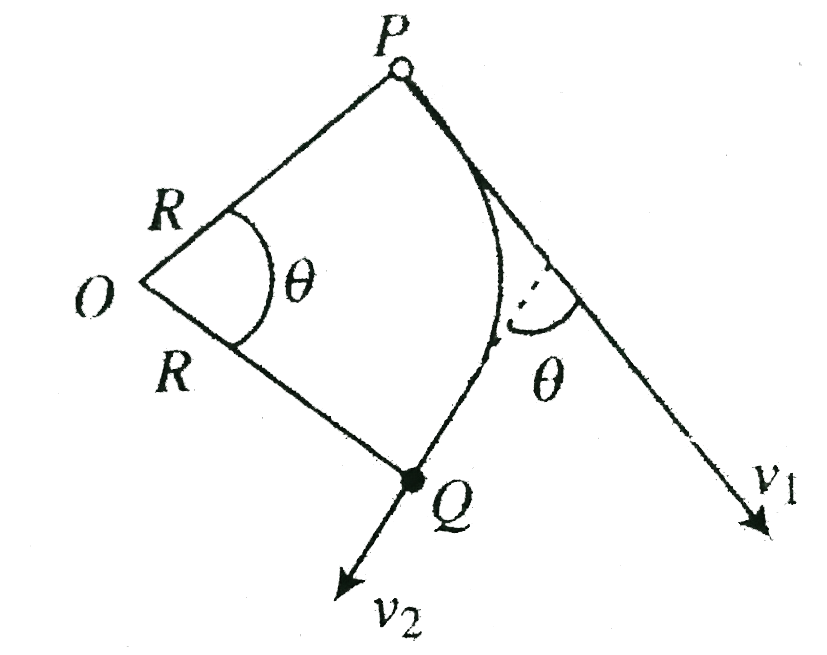A particle describes an angle θ in a circular path with a constant speed v. Find the a charge in the velocity of the particle and b average acceleration of the particle during the motion in the curve (circle).
 .
.
a. As the particle moves from P to Q. The velocty turns through an angle θ. Then,
|Δ→v|=√v21+v22−2v1v2cosθ
=√v2+v2−2∨cosθ=2vsin(θ2)
b. The time of motion is Δt=Rθ/v. Then, average acceleration is |→aav|=→vΔ.
Substituting |Δ→v| and Δ, we have |→aaV|=2vsin(θ2)Rθv=sin(θ2).
Topper's Solved these Questions
- BOOK - CENGAGE PHYSICS ENGLISHCHAPTER - KINEMATICS-1EXERCISE - Solved Examples9videos
KINEMATICS-1
- BOOK - CENGAGE PHYSICS ENGLISHCHAPTER - KINEMATICS-1EXERCISE - Exercise 4.117videos
KINEMATICS-1
- BOOK - CENGAGE PHYSICS ENGLISHCHAPTER - GRAVITATIONEXERCISE - INTEGER_TYPE1videos
GRAVITATION
- BOOK - CENGAGE PHYSICS ENGLISHCHAPTER - KINEMATICS-2EXERCISE - Exercise Integer9videos
KINEMATICS-2
Similar Questions
A particle moving with uniform acceleration along a straight line ABC rosses point A at t=0 with a velocity 12ms−1.B is 40m away from A andC is 64m away from A. The particle passes B at t=4 s.a.Afterwˆtimewillthepartic≤beatC?b.WˆisitsvelocityatC?c.Wˆdoesthepartic≤reachAaga∈?d.Locatethep∮wherethepartic≤reversesitsdirectionofmotion.e.F∈dthedistancecoveredbythepartic≤∈thefirst15 s.
04:04View Solutiona. If the velocity of a body is zero, does it mean that its acceleration is also zero ? (Yes//No)
b. If the acceleration of a body is zero does it mean that its velocity is also zero ? (Yes//No)
c. If a body travels with uniform acceleration a1 for a time t2 thenthe average acceleration is given by
aav=a1t1+a2t2t1+t2(Yes/No)<br>d.Ifabody⋆tsomrestandmoveswithuniformae≤rationthedisplacemectsofthebodyis1 s,<br>2 s, 3 s,etc.,are∈therationof(1:4:9),etc.(True/False)
e. For a body moving whith uniform acceleration, the displacent of the bosy in successive seconds is in the ration of 1:3:5:7.........................(True//False) .03:58View SolutionGravitational acceleration on the surface of a planet is √611g. where g is the gravitational acceleration on the surface of the earth. The average mass density of the planet is 23 times that of the earth. If the escape speed on the surface of the earht is taken to be 11kms−1 the escape speed on the surface of the planet in kms−1 will be
02:52View SolutionA particle is projected with velocity u at angle θ with horizontal. Find the time when velocity vector is perpendicular to initial velocity vector.
View SolutionA particle is moving with a constant speed in a circular path. Find the ratio of average velocity to its instantaneous velocity when the particle rotates an angle theta =((pi)/(2)) .
07:41View SolutionA particle describes an angle θ in a circular path with a constant speed v. Find the a charge in the velocity of the particle and b average acceleration of the particle during the motion in the curve (circle).
 . 02:25View Solution
. 02:25View SolutionA particle moves with constant speed v along a circular path of radius r and completes the circle in time T. The acceleration of the particle is
02:25View SolutionA particle is moving on a circular path of radius R with constant speed v. During motion of the particle form point A to point B
01:40View SolutionA particle is moving with constant speed v on a circular path of 'r' radius when it has moved by angle 60^(@) , Find (i) Displacement of particle (ii) Average velocity (iii) Average acceleration
04:39View Solutionएक कण एकसमान चाल से वृताकार पथ पर चक्क्र लगता है कण का त्वरण है :
02:43View SolutionA particle is moving on a circular path with constant speed v. The magnitude of the change in its velocity after it has described an angle of 90^(@) is :
00:47View SolutionThe angle between velocity and acceleration of a particle describing uniform circular motion is
04:32View SolutionA particle is moving on a circular path of radius R with constant speed v. During motion of the particle form point A to point B
 01:21View Solution
01:21View SolutionA particle is moving with a constant speed in a circular path. Find the ratio of average velocity to its instantaneous velocity when the particle rotates an angle θ=(π2) .
View SolutionA particle moves with constant speed v along a circular path of radius r and completes the circle in time T. The acceleration of the particle is
06:11View Solution

